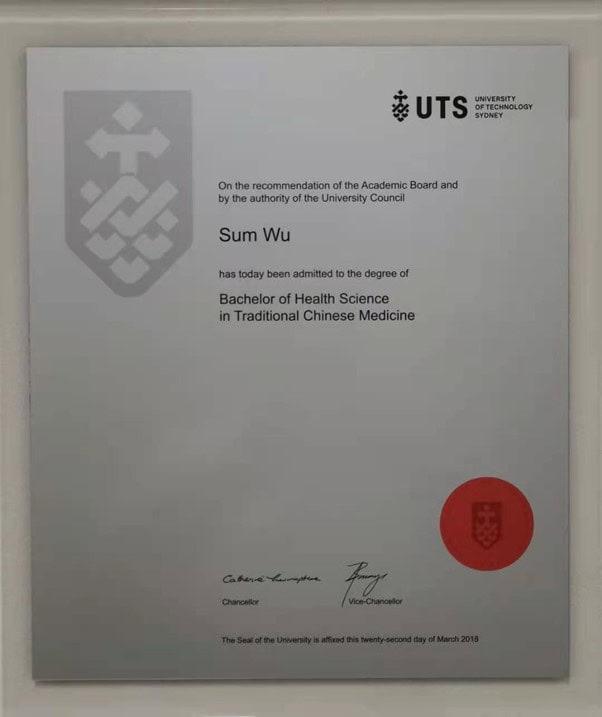 2025年09月09日 14:37 發布
編輯:Editor
2025年09月09日 14:37 發布
編輯:Editor
Sum Wu
Registered Chinese Medicine Practitioner
Bachelor of Health Science in Traditional Chinese Medicine (UTS)
Bachelor of Science Majoring in Psychology (UOW)
Director of Hurstville Chinese Herbs Centre
Vice Dean of College of Traditional Chinese Medicine Orthopedics Australia
Specialising in pain management and mental wellbeing through Tradition Chinese medicine in combination with modern science in mental health, dieting and nutrition.
吳宇琛,澳大利亞政府注册中醫師、針灸師,五龍崗大學心理學學士、悉尼科技大學中醫系學士,澳大利亞松軒中醫藥中心主任醫師,澳大利亞中醫骨傷專科學院副院長。
擅長用傳統針灸理傷手法和中藥治療各種新舊損傷痛症,特別採用中醫中藥和現代心理學、營養學相結合調理治療各種慢性病和亞健康。

In recent years, both Traditional Chinese Medicine (TCM) practices and contemporary manual therapy methods have gained popularity for their effectiveness in treating musculoskeletal pain, improving circulation, and enhancing recovery. Among these approaches, Gua Sha and the Graston Technique are two methods that share similarities yet arise from very different cultural and clinical origins.
近年來,中醫傳統療法與現代手法治療因其在治療肌肉骨骼疼痛、改善循環和促進康復方面的療效而逐漸受到歡迎。在這些方法中,刮痧與Graston技術既有相似之處,又源自截然不同的文化與臨床背景。
Origins and Philosophies起源與理念
Gua Sha is a traditional healing method that has been practiced in China and other parts of Asia for centuries. The name translates to “scraping sand,” referencing the reddish or purplish marks that often appear on the skin after treatment. Rooted in TCM principles, Gua Sha is based on the belief that stagnation of Qi and blood can cause pain or illness. By scraping the skin with a smooth-edged tool, practitioners aim to restore circulation, release heat, and stimulate the body’s self-healing mechanisms.
刮痧是一種傳統的治療方法,在中國及其他亞洲地區已有數百年的應用歷史。其名稱意為“刮痧”,指的是治療後皮膚上常見的紅色或紫色痕迹。刮痧植根於中醫理論,認為氣血瘀滯會導致疼痛或疾病。通過使用光滑邊緣的工具刮拭皮膚,施術者旨在促進氣血流通,清解鬱熱,並激發人體的自愈能力。
The Graston Technique, on the other hand, was developed in the United States in the 1990s as a specialized form of instrument-assisted soft tissue mobilisation (IASTM). Grounded in Western biomedical science, it focuses on breaking down scar tissue and fascial restrictions that can develop after injury, surgery, or chronic overuse. Graston is highly systematised, taught through certification programs, and supported by clinical research in sports medicine and rehabilitation.
Graston技術則於20世紀90年代在美國發展起來,是一種專門的器械輔助軟組織鬆動術(IASTM)。它基於西方生物醫學,主要針對因損傷、手術或長期過度使用而形成的瘢痕組織與筋膜粘連。與刮痧不同,Graston技術體系化程度很高,通過認證課程進行培訓,並在運動醫學和康復領域有臨床研究支持。
Tools and Methods工具與方法
Both methods use tools to apply friction to the skin, but their instruments differ in appearance and materials.
兩種方法都借助工具在皮膚上產生摩擦,但其器具的材質與外形有所不同。
Gua Sha tools are traditionally made from jade, horn, porcelain, or metal. They often have smooth, curved edges to glide comfortably across the skin after oil is applied. The technique usually involves repeated unidirectional strokes over muscles or meridian pathways.
刮痧工具傳統上使用玉石、牛角、瓷器或金屬製成,常帶有光滑弧形邊緣,在塗抹油脂後能順暢地滑動。手法通常是沿著肌肉或經絡反復進行單向刮拭。
Graston instruments are stainless steel with bevelled edges, designed with different shapes to target specific anatomical regions. Practitioners use varied strokes and pressures depending on the tissue being treated, often within the context of a broader rehabilitation program including stretching and strengthening.
Graston器械則由不銹鋼製成,邊緣呈斜角,有多種不同形狀,以便針對不同解剖區域。施術者會根據治療的組織特點選擇不同的力度和手法,並常結合拉伸與強化訓練等康復方案一同使用。
Effects and Benefits作用與益處
Despite different origins, Gua Sha and Graston share a key therapeutic goal: mobilizing soft tissue to improve function and reduce pain.
儘管起源不同,刮痧與Graston都以促進軟組織活動、改善功能和減輕疼痛為共同目標。
Gua Sha benefits often include relief from muscle tension, headaches, and conditions associated with poor circulation or inflammation. Modern studies suggest that the technique may promote microcirculation and stimulate an anti-inflammatory response. Many patients also report a sense of relaxation and improved range of motion after treatment.
刮痧的好處通常包括緩解肌肉緊張、頭痛以及與血液循環不良或炎症相關的問題。現代研究顯示,刮痧可促進微循環,並激發抗炎反應。許多患者在治療後還會感到身心放鬆,關節活動度有所改善。
Graston Technique benefits are particularly noted in sports medicine and physical therapy. It is frequently used for conditions such as tendinopathies, plantar fasciitis, carpal tunnel syndrome, and post-surgical scarring. Research has shown improvements in tissue mobility, reduced pain, and quicker return to activity in athletes and patients undergoing rehabilitation.
Graston技術在運動醫學和物理治療領域尤為突出。它常用於治療肌腱病、足底筋膜炎、腕管綜合征以及術後疤痕等疾病。研究表明,該技術可改善運動員和康復患者的組織活動能力,減輕疼痛,並加快恢復活動能力。
Key Differences主要區別
While the methods appear similar on the surface, several distinctions are important:
表面上看,兩種方法相似,但其差异不容忽視:
Integrative Potential融合與發展
Today, practitioners are increasingly recognising the value of blending traditional and modern approaches. Gua Sha offers a holistic perspective and centuries of clinical experience, while Graston provides evidence-based methods and integration into rehabilitation programs. Patients may benefit from both, depending on their condition, cultural preferences, and treatment goals.
如今,越來越多的臨床實踐者開始認識到結合傳統與現代方法的價值。刮痧提供了整體觀念和數百年的臨床經驗,而Graston則帶來循證方法與康復體系的綜合。根據病情、文化偏好與治療目標,患者可能同時受益於兩者。
In essence, Gua Sha and the Graston Technique illustrate how different healing traditions can converge on similar ideas: that targeted mechanical stimulation of soft tissue can help restore movement, reduce pain, and enhance the body’s natural healing processes.
總體而言,刮痧與Graston技術展示了不同的治療傳統如何在相似理念上匯聚:通過針對性的軟組織機械刺激,幫助恢復運動功能,減輕疼痛,並促進身體的自然康復過程。
如有疑問想咨詢吳宇琛中醫師,可以在微信或whatsapp搜索61 404836368,加吳宇琛中醫師微信或whatsapp,也可以發短信或致電0404836368作語音留言,吳宇琛中醫師有空就會回復。
(吳宇琛中醫師,澳大利亞政府注册中醫師、針灸師,五龍崗大學心理學學士、悉尼科技大學中醫系學士,悉尼好思維松軒藥行主任中醫師,澳大利亞中醫骨傷專科學院副院長,本文僅供參考,具體診療應諮詢專業人士。)
